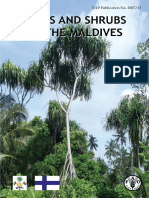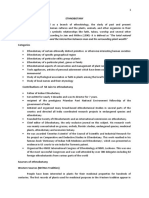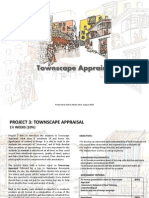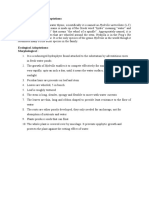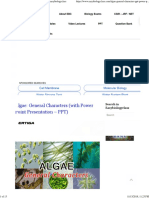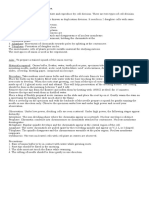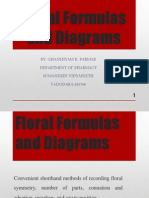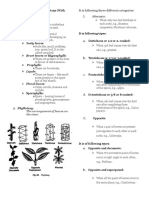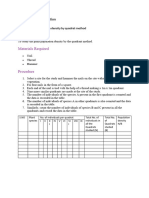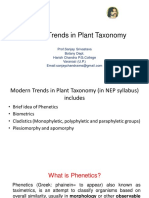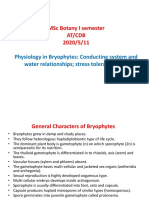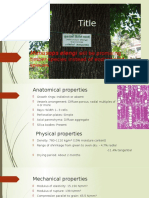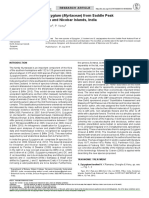0 ratings0% found this document useful (0 votes)
2K viewsLecture 6 - Inflorescence PDF
An inflorescence is a cluster of flowers arranged in a fixed pattern on the main stem. It contains multiple florets arising from the stem axis. Inflorescences can be determinate, with the oldest flower at the tip, or indeterminate, with the youngest flower at the tip. There are several types of inflorescences including racemes, spikes, corymbs, umbels, heads, and cymes. Compound inflorescences are formed from multiple single inflorescences grouped together, such as panicles and compound umbels.
Uploaded by
Thivya RamanCopyright
© © All Rights Reserved
We take content rights seriously. If you suspect this is your content, claim it here.
Available Formats
Download as PDF, TXT or read online on Scribd
0 ratings0% found this document useful (0 votes)
2K viewsLecture 6 - Inflorescence PDF
An inflorescence is a cluster of flowers arranged in a fixed pattern on the main stem. It contains multiple florets arising from the stem axis. Inflorescences can be determinate, with the oldest flower at the tip, or indeterminate, with the youngest flower at the tip. There are several types of inflorescences including racemes, spikes, corymbs, umbels, heads, and cymes. Compound inflorescences are formed from multiple single inflorescences grouped together, such as panicles and compound umbels.
Uploaded by
Thivya RamanCopyright
© © All Rights Reserved
We take content rights seriously. If you suspect this is your content, claim it here.
Available Formats
Download as PDF, TXT or read online on Scribd
You are on page 1/ 19
INFLORESCENCE
Learning outcome:
i.
To define inflorescence.
ii. To identify the parts of an inflorescence.
iii. To differentiate inflorescence from simple
flower.
iv. To compare determinate and indeterminate
inflorescence.
v. To describe the types of inflorescence.
Some flowers do not appear solitary in a stem.
They are generally arranged in a fixed pattern we
call inflorescence.
An inflorescence may be defined as a cluster of
flowers, all flowers arising from the main stem
axis or peduncle.
Flowers included in
generally called florets.
the
inflorescence
are
Inflorescences with youngest flower at the end of
the main axis (rachis) are called "indeterminate"
(i.e. terminal bud continues to produce new
flowers).
Inflorescences with oldest flower at the end of the
main axis are called "determinate" (i.e. terminal
bud stops growing and lateral flowers are
produced from axillary buds.)
Inflorescences can be:
Single: when all the flowers are gathered in the
same single pattern.
Compound: when a complex pattern is made of
another single patterns.
Main single inflorescences
1. Raceme - Florets are attached along a floral
peduncle with stems similar in length. Young
florets appear above and old ones below.
2. Spike - Inflorescences similar to racemes, but florets
are attached directly to the floral peduncle,without
stems.
3. Corymb - All the florets are arranged along a
floral peduncle but, differently to racemes, stems
have different length in such a way that all the
florets appear at the same flat round level. Each
flower stem originates from different point on the
main stem. Outer flowers opens first.
4. Umbel - Florets arise from the same point of the
peduncle.
5. Head / Capitulum - Florets bearing no stem are
gathered together on a platform-shaped peduncle.
This is the inflorescence characteristic in the daisy
family.
Ray floret
Disc floret
Involucre
6. Cyme - a central flower opens first and later
flowers are borne on branches below it. Some
cymes are one-sided (scorpioid cymes)
7. Catkin - a pendulous inflorescence, made up of
many small stalkless flowers.
8. Spadix - a thick, fleshy spike of unisexual,
apetalous flowers, often surrounded by a vaseshaped or funnel-like modified leaf or spathe
which is often brightly colored. The male flowers
are typically clustered above the female flowers
on an erect, phallus-like spike.
Main compound inflorescences
1. Panicles - formed by several racemes
gathered together.
2. Compound umbels - formed by several
umbels gathered together.
FLOWER EVOLUTION
Primitive traits
Advanced traits
Flower parts many
Flower parts of an indefinite
number
Flower parts free
Flower parts spirally
arranged
All types of flower parts
present
Flowers bisexual
Ovary superior
Flower of regular symmetry
Flowers conspicuous
Ovules exposed
Flower parts few
Flower parts of a definite
number
Flower parts fused
Flower parts whorled
Some types of flower parts
missing
Flowers unisexual
Ovary inferior
Flower of irregular symmetry
Flowers inconspicuous
Ovules enclosed
You might also like
- Principles of Seed Science and TechnologyNo ratings yetPrinciples of Seed Science and Technology478 pages
- 13D-13.2 Tissues Systems in Plants Flow Chart SummaryNo ratings yet13D-13.2 Tissues Systems in Plants Flow Chart Summary1 page
- Vi Semester B. SC Zoology Practicals Study of Embryological Slides Frog Blastula100% (1)Vi Semester B. SC Zoology Practicals Study of Embryological Slides Frog Blastula11 pages
- Ecological Adaptations in Hydrophytes and XerophytesNo ratings yetEcological Adaptations in Hydrophytes and Xerophytes9 pages
- Nostoc - Structure Different Types of Reproduction and Importance100% (1)Nostoc - Structure Different Types of Reproduction and Importance5 pages
- General Characteristics of Algae With Key Points - Easybiologyclass0% (2)General Characteristics of Algae With Key Points - Easybiologyclass13 pages
- Cytotaxonomy/ Cytological: Study of Nucleus and Cytoplasm100% (1)Cytotaxonomy/ Cytological: Study of Nucleus and Cytoplasm5 pages
- Botany - B.SC - (Sub.) - I - Gymnosperms Classification & Economic Importance - Dr. Sanjeev Kumar Vidyarthi - Lecture Seq - No - 10 - 15.04.2020100% (2)Botany - B.SC - (Sub.) - I - Gymnosperms Classification & Economic Importance - Dr. Sanjeev Kumar Vidyarthi - Lecture Seq - No - 10 - 15.04.20204 pages
- Podocarpus: Coniferopsida: Fouzia Youseph M.SC Botany (Sem2)100% (1)Podocarpus: Coniferopsida: Fouzia Youseph M.SC Botany (Sem2)9 pages
- Experiment: 2. Study of Museum SpecimensNo ratings yetExperiment: 2. Study of Museum Specimens12 pages
- Study of Polyploidy in Onion Root Tip Cells by Colchicine TreatmentNo ratings yetStudy of Polyploidy in Onion Root Tip Cells by Colchicine Treatment3 pages
- Study of Plant Population by Quadrat MethodNo ratings yetStudy of Plant Population by Quadrat Method2 pages
- Moderns Trends in Plant Taxonomy-15-03-2023No ratings yetModerns Trends in Plant Taxonomy-15-03-202329 pages
- Virtual Herbarium, Documentation and KeysNo ratings yetVirtual Herbarium, Documentation and Keys12 pages
- Diversity of Seed Plants and Their Systematics by DR Nupur Bhowmick100% (2)Diversity of Seed Plants and Their Systematics by DR Nupur Bhowmick26 pages
- LYGINOPTERIS OLDHAMIA B.Sc. Part II Botany Hons. Prof. (DR.) Manorma Kumari, Botany, ANC100% (1)LYGINOPTERIS OLDHAMIA B.Sc. Part II Botany Hons. Prof. (DR.) Manorma Kumari, Botany, ANC6 pages
- Blood Vascular System of Herdmania-part-II-zoologyNo ratings yetBlood Vascular System of Herdmania-part-II-zoology6 pages
- Lecture 4 Sexual Reproduction in PlantsNo ratings yetLecture 4 Sexual Reproduction in Plants40 pages
- Interpreting Symbols: E.G - Flying Desire For Freedom, Desire To Travel E.G - SnakesNo ratings yetInterpreting Symbols: E.G - Flying Desire For Freedom, Desire To Travel E.G - Snakes2 pages
- Ashwini London English Monday Christmas December Taman Rakyat Emir Saturday SarawakNo ratings yetAshwini London English Monday Christmas December Taman Rakyat Emir Saturday Sarawak1 page
- Immediate Download (PowerPoint) Consumer Behavior Buying Having and Being 12th Edition Michael R. Solomon All Chapters100% (2)Immediate Download (PowerPoint) Consumer Behavior Buying Having and Being 12th Edition Michael R. Solomon All Chapters34 pages
- Bohs, 2001 - Revision of Solanum Section CyphomandropsisNo ratings yetBohs, 2001 - Revision of Solanum Section Cyphomandropsis86 pages
- Anp 508 October 2023 25 Botany of Grasses and LegumesNo ratings yetAnp 508 October 2023 25 Botany of Grasses and Legumes22 pages
- Spirogyra (Spiro Coiled and Gyra Curved) .: External Features and Cell StructureNo ratings yetSpirogyra (Spiro Coiled and Gyra Curved) .: External Features and Cell Structure112 pages
- Olive: Phenological Growth Stages and BBCH-identification Keys of Olive TreeNo ratings yetOlive: Phenological Growth Stages and BBCH-identification Keys of Olive Tree5 pages
- (Ebook) Biology and Chemistry of Jerusalem Artichoke: Helianthus tuberosus L. by Stanley J. Kays, Stephen F. Nottingham ISBN 9781420044959, 1420044958 - The full ebook with all chapters is available for download now100% (1)(Ebook) Biology and Chemistry of Jerusalem Artichoke: Helianthus tuberosus L. by Stanley J. Kays, Stephen F. Nottingham ISBN 9781420044959, 1420044958 - The full ebook with all chapters is available for download now47 pages
- Network Analysis Using Wireshark 2 Cookbook: Practical Recipes To Analyze and Secure Your Network Using Wireshark 2, 2nd Edition Nagendra Kumar Nainar All Chapter Instant Download100% (5)Network Analysis Using Wireshark 2 Cookbook: Practical Recipes To Analyze and Secure Your Network Using Wireshark 2, 2nd Edition Nagendra Kumar Nainar All Chapter Instant Download25 pages
- Int Gtr277 Vascular Flora of West Central Montana Karl LackschewitzNo ratings yetInt Gtr277 Vascular Flora of West Central Montana Karl Lackschewitz654 pages
- PDF Apocalypse 1. Auflage Edition Flammarion download100% (9)PDF Apocalypse 1. Auflage Edition Flammarion download67 pages
- Waterfowl Management Handbook: Nutritional ValueNo ratings yetWaterfowl Management Handbook: Nutritional Value6 pages
- CBSE Class 11 Biology Chapter 5 - Morphology of Flowering Plants Important Questions 2022-23No ratings yetCBSE Class 11 Biology Chapter 5 - Morphology of Flowering Plants Important Questions 2022-2334 pages
- Physiology of Flowering in Mango: MD Aayesha Jameel, SM Rajesh Naik, C Madhumathi, D Srinivasa Reddy and KT VenkataramanaNo ratings yetPhysiology of Flowering in Mango: MD Aayesha Jameel, SM Rajesh Naik, C Madhumathi, D Srinivasa Reddy and KT Venkataramana8 pages
